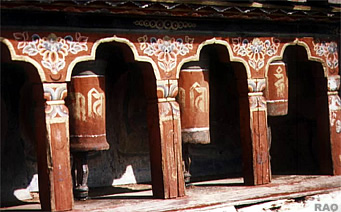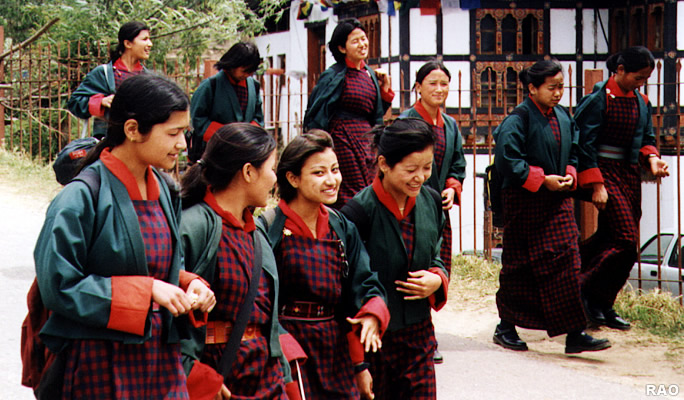|
As
colourful as tradition
|
 |
Bhutan's
Culture |
|
 |
Bhutan Information |
|
|
 |
|
A
Culture means the perfect and equal development of man on all sides
|
| KUENSEL
Editorial |
 |
As
our dzongdas don their smart new kabneys (scarves) we can only wonder if
this is what makes us a unique society. Even as popular psyche discards
social norms we are creating a hierarchy that could appear to contradict
universal thinking. And, as long as we place it in the right perspective,
we might still make sense of it.
The
kabney is not just a symbol of Bhutanese tradition. It is now becoming
a more detailed colour code for positions within society.
 |
| We
have more than a dozen coloured scarves representing rank and function
in the system of governance, including several new designs introduced in
recent years.
All
this is taking place when we are promoting an ICT culture that knows no
social boundaries, when we are heading for general elections where political
leaders have to show versatility rather than rigidity in terms of hierarchy,
and when many of our youth go out into the world and return with coloured
hair and trouser fashions that originated in American prisons. |
|
But
colour is the face of beauty. Bhutan is appreciated by the world because
it displays the pristine colours of nature that is woven into our clothes
and embedded into our culture. When we attend international gatherings
we bring a much-needed relief to the gray suits that has become the attire
for officialdom. It is, therefore, with pride that we display the absence
of inhibition by wearing strong colours.
It
is also important that the façade does not become the identity.
The
person behind the scarf and what that person does will always be more important.
We would not want the personality to be overshadowed by the scarf just
as we do not want to be known to our children by our worth measured in
civil service grades.
And
it is vital that officialdom, in all its colour, presents a non intimidating
image to our youth. Tradition is at risk when the young reject it. Today
our youth sense the excitement of change.
So
we convey our support for change in every way possible, particularly by
enabling tradition to evolve.
Politics
will have its own impact on change. As we go in for general elections it
is important that we see potential leaders for their real worth and not
as former lyonpos, dashos, farmers, or shopkeepers. We have to vote for
an individual going by his or her capability.
Meanwhile,
we hope that the kabneys and the swords and the colours continue to maintain
a heritage and a system of values that must never be lost.
| Contributed
by Kuensel, Bhutan's National Newspaper, 2006 |
 |
|




